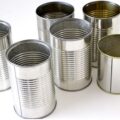The thickness of tinplate for metal containers is determined by several factors, including the type of container, its end use, and the required mechanical properties. Here are some specific details to consider when determining tinplate thickness:
- Standard Thickness: Thicknesses vary from 0.20 mm to 0.36 mm for different types of containers.
- Type of packaging:
- For container rings to contain ½ to 1 liter of product, a T2 temper and a gauge of 0.26 to 0.29 mm is recommended.
- For tinplate containers of 1 and 5 liters capacity, thicknesses of 0.21 mm are mentioned.
- For tinplate containers of 1 liter capacity, a thickness of 0.20-0.21 mm is quoted.
- Temple:
- It is mentioned that for containers, a suitable quench is in the range of 55 – 60 °R (Rockwell), and for aerosol bottoms, 65 – 66 °R.
- Type of reduction:
- Tinplate can be single reduction (SR) or double reduction (DR), which also influences the final thickness of the material.
- Tinplate thicknesses can range from 0.13 mm to 0.28 mm.
- Physical Resistance:
- A balance between thickness and hardness is sought to optimize the axial and radial resistance of the container, especially when thinner tinplate tends to be used.
- Tin coating:
- An inner coating with a tin layer of 2.8 g/m2 is mentioned for certain containers, which is a factor to be considered together with the thickness of the base metal.
- Type of Packaging and End Use:
- Consideration should be given to the type of container, such as whether it is a “3-piece” or “2-piece” container, and the end use of the container, as this may require specific material properties.
It is important to consider that each manufacturer may have its own detailed specifications and standards that determine the optimum tinplate thickness for each type of container and application. Therefore, these recommendations should be tailored to specific product needs and manufacturing requirements.














